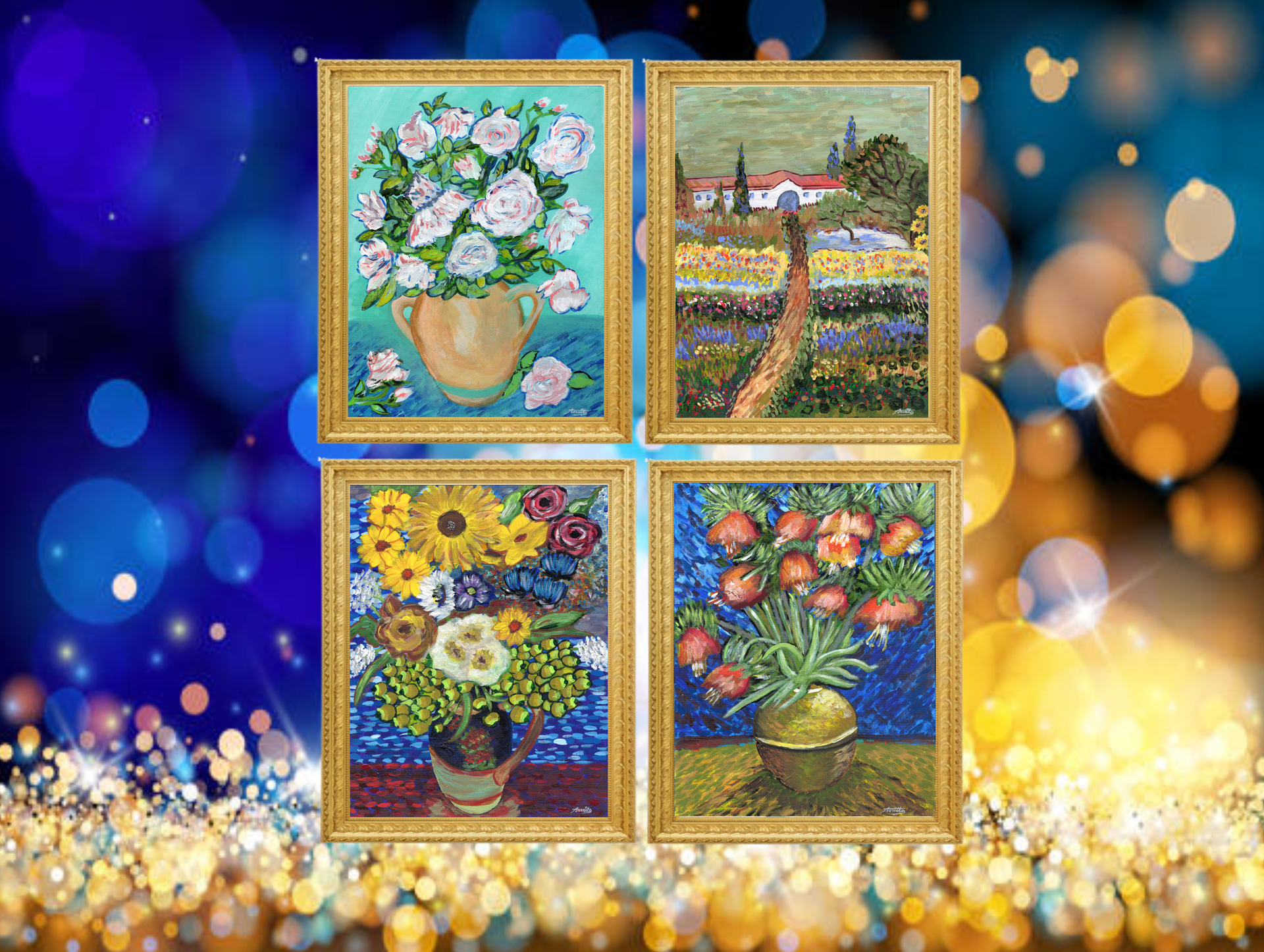
Few artists have left as indelible a mark on the art world as Vincent van Gogh. His vibrant use of color, emotionally charged brushstrokes, and expressive compositions turned ordinary scenes into profound visual experiences. Among his most beloved works are his flower paintings — especially his iconic sunflowers, irises, and almond blossoms. These pieces, bursting with life and emotion, serve as a perfect window into his psyche and his style. Today, artists and enthusiasts continue to study and recreate these works, not only to honor Van Gogh’s legacy but to reinterpret his floral visions through modern lenses.
In this blog post, we’ll explore what makes Van Gogh’s flower paintings so powerful, how his unique brushstrokes breathe life into each petal and leaf, and why recreating his work can be a deeply rewarding exercise in artistic expression and historical connection.
Van Gogh didn’t just paint flowers — he communicated with them. His flowers were more than still lifes; they were portraits of emotion, often reflecting his internal states. In “Sunflowers,” for example, the yellow hues evoke warmth, hope, and the fleeting beauty of life. In “Irises,” the blue tones hint at melancholy and contemplation. Meanwhile, “Almond Blossoms,” with its delicate white flowers against a serene blue sky, symbolizes rebirth and new beginnings — a gift for his newborn nephew.
What makes these paintings compelling isn’t just their subject matter, but how Van Gogh approached them: not with scientific precision, but with empathy and energy. He painted from the heart, turning each bloom into a vessel of feeling.
Central to Van Gogh’s expressive power was his brushwork — thick, impasto strokes that seem to pulse with vitality. He often painted quickly and spontaneously, applying paint in swirling, rhythmic patterns. These were not random gestures. Each stroke captured a sense of movement, mimicking the natural growth and liveliness of his subjects.
In his floral paintings, this technique shines. The petals in “Irises” twist and bend as if caught in a breeze. The sunflowers droop or reach upward with individual character. The almond blossoms seem almost to sway gently on their branches. His brushwork infused each scene with a kinetic energy, making the viewer feel as if the flowers are still alive — breathing, growing, moving.
For artists looking to recreate Van Gogh’s work, understanding and adopting his brushstroke technique is essential. It’s not just about replicating what you see, but about capturing the motion and emotion behind each stroke.
Recreating Van Gogh’s floral masterpieces isn’t about copying them perfectly — it’s about embodying his spirit and technique. Here are some essential tips for artists:
Van Gogh didn’t shy away from color. His palette was emotional, not realistic. When recreating his work, choose vibrant, contrasting hues. Allow yellows, blues, oranges, and greens to dominate. Push your colors to their emotional edge.
Van Gogh used thick layers of paint to create texture. This impasto technique adds depth and light-play to the canvas. Don’t be afraid to load your brush or palette knife and let the paint stand on the surface.
Avoid over-blending. Let each stroke be visible and deliberate. Think about how a curve of paint can mimic the shape of a petal or the tension of a stem. Van Gogh’s strokes were often directional, flowing with the form of his subject.
Van Gogh rarely overwhelmed the viewer with detail. Instead, he focused on the essence of the subject. When recreating his flower works, emphasize form and movement over realism. Let the flowers breathe.
Above all, Van Gogh painted how he felt about a scene, not just how it looked. If you’re painting irises, consider their symbolism — are you feeling calm, introspective, or hopeful? Infuse your strokes with that emotion.
Recreating Van Gogh’s floral paintings isn’t just a technical exercise — it’s a form of emotional and artistic connection. Whether you’re a beginner learning the basics of color and brushwork, or an experienced artist interpreting his work in your own style, the act of reimagining these paintings helps develop a more intimate understanding of what makes them timeless.
It also offers a moment of mindfulness. As Van Gogh himself wrote in a letter to his brother Theo: “I am always doing what I cannot do yet, in order to learn how to do it.” Recreating his work allows you to practice this philosophy — to push boundaries, make mistakes, and discover new facets of your own creativity.
Modern artists are not only recreating Van Gogh’s work but reinterpreting it in innovative ways. Some infuse his techniques with contemporary themes — climate change, technology, or cultural identity. Others merge Van Gogh’s brushwork with digital tools or mixed media. Even fashion designers and interior artists draw on his flower motifs and color palettes.
This reinterpretation is what keeps Van Gogh’s flowers from withering with time. Every new version, every modern take, adds another layer to the ongoing conversation between artist and artwork, between past and present.
Recreating Van Gogh’s flower art is more than a tribute — it’s an act of cultivation. Like gardeners tending to a beloved bloom, artists continue to nurture his legacy by revisiting and reinventing his floral compositions. His brushstrokes, full of life and movement, remain a template for those who seek to blend technique with emotion.
Whether you’re painting your own version of “Sunflowers” or letting the spirit of “Almond Blossoms” guide your brush, remember: you’re not just painting flowers. You’re painting feeling — and in doing so, keeping Van Gogh’s vibrant garden forever in bloom.
If you’re inspired to try your own Van Gogh flower painting, start simple. Choose one piece that speaks to you. Study it. Then, let your brush move as he did — boldly, emotionally, and with purpose. The flowers will come to life in your hands, just as they did in his.